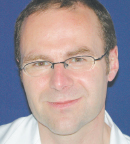
It’s reasonable to stop [rituximab] maintenance and observe patients after 5 to 7 years, but I don’t think it’s prudent to stop at 2 years.— Michael Auerbach, MD
Tweet this quote
Patients with follicular lymphoma are clearly living longer without disease progression, but what clinician has had no patients progress? Michael Auerbach, MD, a hematologist/oncologist in private practice in Baltimore and Clinical Professor of Medicine at Georgetown University, may have these bragging rights. After 18 years of treating 25 consecutive patients with low-grade high–tumor burden follicular lymphoma, his progression-free survival rate remains 100%.
“I want to make it perfectly clear that I am not a lymphoma specialist!” Dr. Auerbach emphasized in an interview with The ASCO Post. He is a specialist in the area of intravenous iron therapy for iron-deficient anemia and has published widely on that topic.
The ASCO Post’s Editor-in-Chief, James O. Armitage, MD, The Joe Shapiro Professor of Medicine at the University of Nebraska, noted that “This is a small observational study, but the results are provocative and interesting.”
The Art of Medicine
Dr. Auerbach’s treatment of follicular lymphoma is clearly an example of “the art of medicine.” Facing a particularly challenging patient in 1995 (the first of 25), and lacking the guidance of an established protocol, he designed a personal treatment plan based on little to no evidence. The remarkable outcome set the stage for his subsequent management approach. The key, he said, is long-term rituximab (Rituxan) maintenance.
As we enter year 18 with a 100% progression-free survival rate, our data remain fascinating to me.— Michael Auerbach, MD
Tweet this quote
Dr. Auerbach and colleagues published their first results in 2010.1 Interestingly, one of the paper’s authors was Patricia Ford, RN, a nurse and epidemiologist who was the seminal patient. Dr. Auerbach updated his results in a 2013 paper,2 in which the authors wrote: “To date, rituximab maintenance therapy in our patient group has been associated with 100% progression-free survival over a median duration of treatment of 71 months, with none of the patients progressing clinically or radiographically while on treatment.” Seven years later, the data have not changed.
“Four years after this publication, we have had zero failures,” Dr. Auerbach revealed. “The coolest part is that we have four patients who stopped treatment after 7 to 14 years. While I have no evidence to support this belief, I think they are never going to relapse,” he predicted.
Complete Remission at Year 18
The success began when Ms. Ford was referred to Dr. Auerbach with low-grade follicular lymphoma. “I watched it, and it grew, and she had clear FLIPI [Follicular Lymphoma International Prognostic Index] criteria for treatment,” he said.
He administered the “chemotherapy du jour” without rituximab (which was not approved until 2000). Predictably, she attained remission and then relapsed. This was followed by “two very difficult chemotherapy regimens, all of which worked and then failed,” he admitted. Ms. Ford became extremely ill, with no more treatment options.
After consulting with other colleagues, Dr. Auerbach obtained rituximab and administered it weekly. “At around 8 weeks, my patient was on death’s door. She was massively swollen and pancytopenic. Her white counts, platelets, and hemoglobin levels all were very low. I recommended hospice. She said she needed to go home, get her affairs in order, and take care of her bunnies.”
The patient continued on rituximab. However, at week 10 or 11, a dramatic change occurred, reported Dr. Auerbach. “Marked diuresis and pancytosis were noted. We continued to week 24 (‘just because’). Astonishingly, 4 weeks later, her hematologic parameters normalized, and shortly thereafter, a bone marrow biopsy was both phenotypically and immunohistochemically normal,” he said.
She continued on rituximab, 4 weeks on and 6 weeks off, for several cycles before reducing the frequency to 3 cycles a year. Although her lymphoma remained at bay, she did, however, develop clinically significant hypogammaglobulinemia and discontinued rituximab 5 years ago. Surprisingly, her disease did not progress. “Now, at year 18, she remains in complete remission,” according to Dr. Auerbach.
“Because of this patient, I started to maintain my other FLIPI-criteria low-grade follicular lymphoma patients on rituximab, and by the time the PRIMA study was released,3 I had a dozen patients and zero failures. We have continued with this approach,” he told The ASCO Post.
Collaborative Efforts

Maria Baer, MD
Dr. Auerbach emphasized that his findings could not have been published without the help of several academic experts at the University of Maryland. Two were Maria Baer, MD, Professor of Medicine and Director of Hematologic Malignancies at the Marlene and Stewart Greenebaum Comprehensive Cancer Center, and Jean Adel Yared, MD, Assistant Professor of Medicine.
Dr. Baer described Dr. Auerbach as “imaginative” and added: “This is outstanding work by a physician in private practice. It is remarkable that a private practitioner decided to do something different that resulted in such good outcomes.”
She added that obtaining help from Dr. Yared, who was a fellow at the time, was “a ‘win-win’ partnership for everyone.” With his help, and that of others, the encouraging findings made their way into the medical literature, she said. Dr. Yared was the first author of the 2013 paper.2
Asked what other hematologists think about the excellent outcomes these researchers reported, Dr. Yared said: “One reaction is, ‘What were you thinking, continuing rituximab for that long?’ Another is, ‘Good for these patients! They are still in remission!’ They also ask, ‘did you get away with this, with the insurance companies?”
According to Dr. Auerbach, coverage has rarely been a problem. “When we send them our data, we have not had pushback,” he reported. A 700-mg infusion of rituximab averages $6,200.
Debate Over Maintenance Therapy Continues
Dr. Yared acknowledged that continuing rituximab indefinitely is an unusual strategy. “Obviously, this is not evidence-based medicine,” he revealed, noting that the best data for maintenance come from the PRIMA trial. At 6 years’ follow-up, 2 years of rituximab maintenance continued to show a benefit, resulting in improved progression-free survival, 59.2% vs 42.7% in the control arm (P < .0001).4 “But there is still no overall survival benefit,” he pointed out.
Arguing against maintenance are results from the RESORT trial,5 “showing that if we re-treat patients at progression, we get the same outcome,” he said. “So it’s challenging to convince ourselves and our patients that continuing maintenance is the way to go. The jury is still not convinced. To be academically correct, we cannot recommend rituximab beyond 2 years on a routine basis.”
Dr. Auerbach acknowledged that the use of maintenance therapy, and its optimal duration, remain debatable, and for good reason. “For patients on rituximab maintenance who stop, then relapse, the recapture rate with the same regimen approaches 100%,” he said. “For this reason, I think it’s reasonable to stop maintenance and observe patients after 5 to 7 years, but I don’t think it’s prudent to stop at 2 years.”
“When I go to [the American Society of Hematology Meeting & Exposition] and listen to lymphoma sessions, there appears to be a general, but not ubiquitous, agreement that maintenance therapy is prudent. The duration has yet to be agreed upon, but many key opinion leaders recommend 5 years,” he added. “In any event, as we enter year 18 with a 100% progression-free survival rate, our data remain fascinating to me.”
He believes the reason for his progression-free survival rate of 100%, much higher than achieved in the PRIMA trial, is that he gives more rituximab. “The majority of my patients got 12 doses a year for the first 2 years, then 6 doses a year until 5 years, and then quarterly,” he indicated.
Publication Details
The 2013 paper by Yared et al (with Dr. Auerbach as senior author) is a retrospective analysis of the outcomes of 25 consecutive, unselected, previously untreated patients with low-grade high tumor–burden follicular lymphoma.2 The median age at diagnosis was 64 years, and 80% had intermediate- or high-risk disease (FLIPI score of 2 or ≥ 3). The mean and median durations of maintenance were 63 and 54 months (range, 39–82 months), and the number of rituximab doses was 45 and 37, respectively.
All patients achieved a partial (44%) or complete (56%) response to induction immunochemotherapy and received ongoing maintenance rituximab. At follow-up, 19 patients (76%) demonstrated a complete response during maintenance and 24%, a partial response. Partial responses improved to complete responses during maintenance for 45.4% of patients.
With a median follow-up of 5.0 years and a mean duration of maintenance of 5.2 years, no relapses occurred. There were 5 deaths unrelated to lymphoma or therapy, for an overall survival rate of 82% at 5 years.
Prolonged maintenance rituximab was well tolerated, with hypogammaglobulinemia being the main adverse event; only two patients required monthly intravenous gammaglobulin due to recurrent infections. Serious infections requiring intravenous antibiotics and hospitalization occurred in only two patients and were associated with low serum immunoglobulins but not neutropenia. There were no episodes of neutropenia, second malignancies, or other complications.
The authors concluded in their paper: “These provocative long-term results suggest that continuous maintenance rituximab beyond 2 years is safe and may be associated with prolonged progression-free survival in patients with follicular lymphoma who achieve an objective response after immunochemotherapy. Our data are intriguing and support the need for corroborating prospective clinical trials to compare finite maintenance rituximab vs treatment until disease progression.” ■
Disclosure: Drs. Auerbach and Baer reported no potential conflicts of interest.
References
1. Ayoola A, Terrell M, Bahrain H, et al: Experience with maintenance rituximab after chemotherapy in patient with low grade lymphoma. Comm Oncol 7:414-417, 2010.
2. Yared J, Kimball A, Baer MR, et al: Rituximab maintenance therapy until progression after rituximab and chemotherapy induction in patients with follicular lymphoma. Clin Lymphoma Myeloma Leuk 13:253-257, 2013.
3. Salles G, Seymour JF, Offner F, et al: Rituximab maintenance for 2 years in patients with high tumour burden follicular lymphoma responding to rituximab plus chemotherapy (PRIMA): A phase 3, randomised controlled trial. Lancet 377:42-51, 2011.
5. Kahl BS, Hong F, Williams ME, et al: Rituximab extended schedule or re-treatment trial for low-tumor burden follicular lymphoma: Eastern Cooperative Oncology Group protocol e4402. J Clin Oncol 32:3096-3102, 2014.


